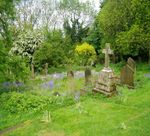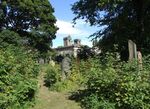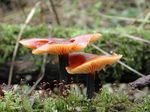Living Churchyards Newcastle & North Tyneside - Newcastle City Council
←
→
Page content transcription
If your browser does not render page correctly, please read the page content below
Living
Churchyards
Churchyards are important places for people but they can also be important
areas for wildlife too. Even in our busy cities these habitats remain largely
undisturbed and numerous plants and animals have space to thrive. So, what is
often a peaceful place for contemplation can also become a haven for wildlife.
Why are churchyards special for wildlife?
Churchyards provide an important and
undisturbed refuge for wildlife as they often
contain a range of habitats such as species
rich grasslands, ponds, hedgerows, woodland
and scrub. They can support a diverse array of
wildlife from insects and micro-organisms,
small mammals and amphibians to a range of
breeding birds. Church buildings can also be
important nest sites for species under threat,
such as swifts, swallows, barn owls and bats
It’s important to remember that a churchyard
managed for wildlife does not thrive on neglect.
A churchyard managed with sympathy and
understanding for wildlife can look well cared
for and be attractive to people as well as
wildlife. Management for wildlife can have
other benefits including the need for less
labour, reducing in particular the burden of very
frequent grass mowing.
Grassland habitat
Many species rich wildflower meadows
have been lost through development, land
intensification and inappropriate
management. Churchyards and
Cemeteries can often be important areas
for grassland habitats as cover and food
for a range of wildlife such as butterflies,
bees, small mammals and amphibians.
It is important that these grasslands are
managed appropriately with an annual end
of summer cut and removal of the grass
clippings to ensure nutrient levels remain
low.
Living ChurchyardsWoodlands and hedgerows
Trees, shrubs and hedgerows are often associated with churchyards, providing an
important source of food, shelter, and nesting sites throughout the year for birds, bats,
mammals and insects. They can also support mature and veteran trees, considered to be
in the ancient stage of their lives and therefore important biologically, culturally and
aesthetically.
The timing of woodland management is extremely important to ensure that any pruning is
undertaken outside of the bird nesting season (March-August). Trees can also provide
important hibernation sites for protected species such as bats, therefore, before carrying
out any work, mature trees or trees with cracks, holes or splits in the bark should be
checked for bats.
Compost heaps & Log Piles
Compost heaps provide habitat for fungi
and invertebrates which in turn become
food for frogs, toads, slow worms and
birds. Grass snakes and hedgehogs may
also hibernate in the heap due to its
warmth.
Log piles also provide vital habitats for
fungi, insects, amphibians and small
mammals such as hedgehogs. Create a
log pile in a hidden corner of a
churchyard by utilising logs and
branches from tree pruning work.
Ponds
Small ponds or marshy areas can be created within churchyards and cemeteries and
provide perfect habitat for frogs, toads and dragonflies. Pond edges can be planted with
native aquatic plants to provide food for wildlife and to help oxygenate the pond.
Pond management should be carried out in the winter when amphibians are in hibernation
away from the pond.
Gravestones and stone walls
Gravestones are important for lichens and
mosses, which vary according to the type of
stone, its age and its exposure to the sun and
weather. Lichens are slow growing and long
lived, some as old as the gravestone itself.
Mosses and lichen should be left untouched if
possible, as they do no harm to the stone.
Church Buildings & Structures
Church buildings are becoming increasingly
important roosting and nesting sites for bats and
birds as other habitats in our urban environment are lost. A survey by the Bat
Conservation Trust estimated that almost 6400 churches and chapels in England may be
Living Churchyardsoccupied by bats. All species of British bat are protected by law and you must seek advice
before carrying out any work likely to affect areas where bats occur.
Wildlife Sites
Some churchyards are designated as Local Wildlife Sites due to their nature conservation
interest. They play a vital role in the conservation of the UK’s natural heritage. For help
with surveys, information on Wildlife Sites and advice on management see contacts
below.
Top tips
Maintain wildflower areas by cutting
once annually and removing grass
cuttings
Pathways to and around the church,
and those to tended places should be
kept mown, together with access to
compost heaps.
Leave small plants/lichens on walls
and monuments.
Erect bird and bat boxes to increase
nesting habitat
Don’t carry out tree or hedge work in
the bird nesting season (March-
August)
Inspect trees for bats prior to
undertaking pruning work.
Site compost heaps away from trees
and botanically rich areas.
Ivy should be left on walls and trees
as it provides nesting sites and a late
source of nectar for insects.
Don’t use chemicals.
Maintain ponds over winter when
amphibians are hibernating.
Contacts
For further help and assistance contact:
Newcastle City Council’s Ecologist
Tel: 0191 277 7195
North Tyneside’s Ecologist
Tel: 0191 643 7279
Northumberland Wildlife Trust
Tel: 0191 284 6884
Living ChurchyardsYou can also read

























































